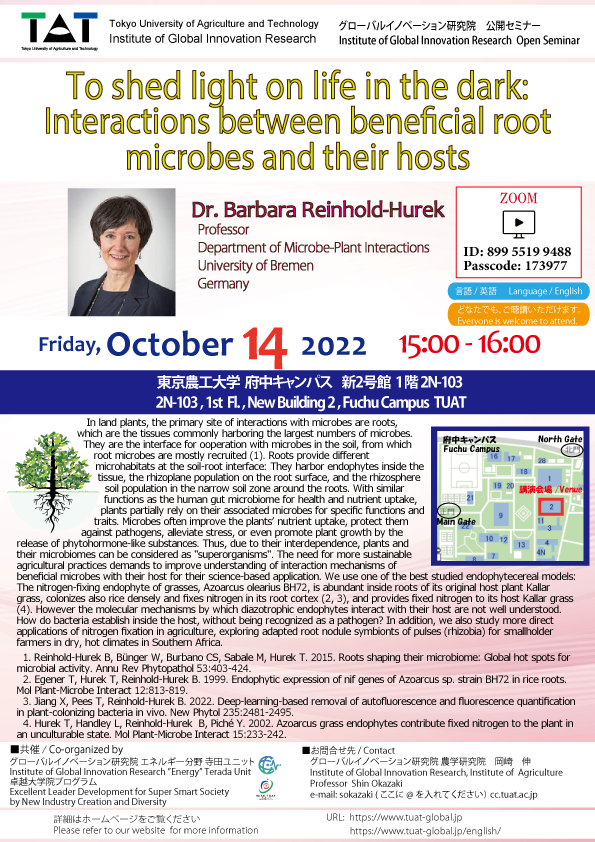イベント情報
【GIR公開セミナー】Dr. Barbara Reinhold-Hurek / ブレーメン大学 (ドイツ)

| 日時 | 2022.10.14(15:00~16:00) |
|---|---|
| 会場 |
ミーティングID:899 5519 9488 パスコード:173977 |
| 講演者 | Dr. Barbara Reinhold-Hurek |
| 所属機関 | ブレーメン大学 (ドイツ) |
| 講演タイトル | ◆講演タイトル "To shed light on life in the dark: Interactions between beneficial root microbes and their hosts" ◆要旨 In land plants, the primary site of interactions with microbes are roots, which are the tissues commonly harboring the largest numbers of microbes. They are the interface for cooperation with microbes in the soil, from which root microbes are mostly recruited (1). Roots provide different microhabitats at the soil-root interface: They harbor endophytes inside the tissue, the rhizoplane population on the root surface, and the rhizosphere soil population in the narrow soil zone around the roots. With similar functions as the human gut microbiome for health and nutrient uptake, plants partially rely on their associated microbes for specific functions and traits. Microbes often improve the plants’ nutrient uptake, protect them against pathogens, alleviate stress, or even promote plant growth by the release of phytohormone-like substances. Thus, due to their interdependence, plants and their microbiomes can be considered as "superorganisms". The need for more sustainable agricultural practices demands to improve understanding of interaction mechanisms of beneficial microbes with their host for their science-based application. We use one of the best studied endophytecereal models: The nitrogen-fixing endophyte of grasses, Azoarcus olearius BH72, is abundant inside roots of its original host plant Kallar grass, colonizes also rice densely and fixes nitrogen in its root cortex (2, 3), and provides fixed nitrogen to its host Kallar grass (4). However the molecular mechanisms by which diazotrophic endophytes interact with their host are not well understood. How do bacteria establish inside the host, without being recognized as a pathogen? In addition, we also study more direct applications of nitrogen fixation in agriculture, exploring adapted root nodule symbionts of pulses (rhizobia) for smallholder farmers in dry, hot climates in Southern Africa. 1. Reinhold-Hurek B, Bünger W, Burbano CS, Sabale M, Hurek T. 2015. Roots shaping their microbiome: Global hot spots for microbial activity. Annu Rev Phytopathol 53:403-424. 2. Egener T, Hurek T, Reinhold-Hurek B. 1999. Endophytic expression of nif genes of Azoarcus sp. strain BH72 in rice roots. Mol Plant-Microbe Interact 12:813-819. 3. Jiang X, Pees T, Reinhold-Hurek B. 2022. Deep-learning-based removal of autofluorescence and fluorescence quantification in plant-colonizing bacteria in vivo. New Phytol 235:2481-2495. 4. Hurek T, Handley L, Reinhold-Hurek B, Piché Y. 2002. Azoarcus grass endophytes contribute fixed nitrogen to the plant in an unculturable state. Mol Plant-Microbe Interact 15:233-242. |
| 言語 | 英語 |
| 対象 | どなたでも、ご参加いただけます。 |
| 共催 | グローバルイノベーション研究院 エネルギー分野 寺田ユニット 卓越大学院プログラム |
| お問い合わせ窓口 | グローバルイノベーション研究院・農学研究院 岡崎 伸 e-mail: sokazaki(ここに@ を入れてください)cc.tuat.ac.jp |
| 備考 | 本セミナーは対面型とオンラインの同時開催講演となります。(後日、動画を配信させていただく予定です。) |
このページの上部へ